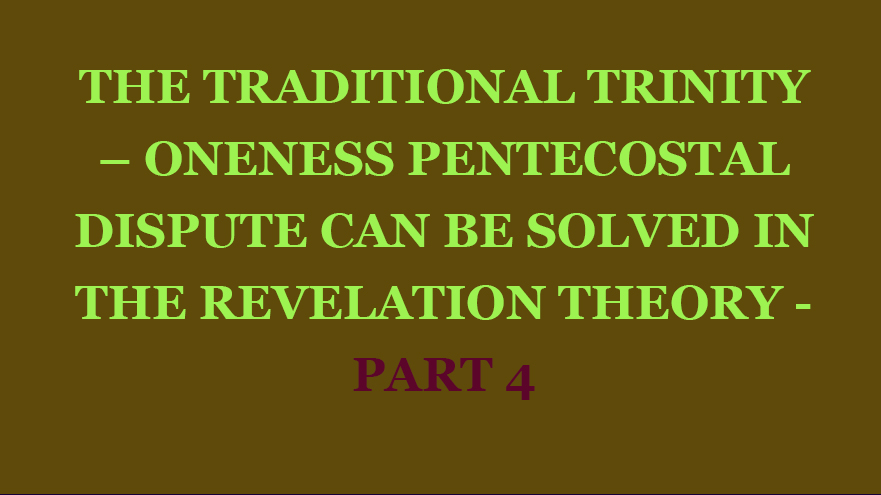
THE TRADITIONAL TRINITY – ONENESS PENTECOSTAL DISPUTE CAN BE SOLVED ONLY IN THE REVELATION THEORY PART 4
THE CLASH BETWEEN THE TRADITIONAL TRINITY AND THE ONENESS UNITARIANS CAN BE RECOCILED AND SOLVED INTO THE FRAMEWORK OF THE REVELATION THEOLOGY.
Many religions and denominations have made their own theories in understanding the nature of the Bible God. And nobody has succeeded in developing an unquestionable explanation. They each get hold of one part of the truth and argue that what they got hold is the full truth about God revealed in the Bible. They all fail like the proverbial blind men trying to figure out the elephant. Hence there is scope for fresh attempts in solving the problem, by making use of the deeper light of the Word of God.
The theories of traditional trinity and the oneness Pentecostalism are rightly consummated in the revelation theory. Both the unipersonal theology and the trinitarian theology can be admitted and rectified at the same time. Traditional trinity problems can be beautifully solved in the revelation theory. Even the Filioque issue is easily solved in this framework of theology. The revelation theory can easily prove that the Biblical God is one supreme person. It can also prove that the members of the trinity are equal in nature because they are all the revelations of the one and the same God. Here the issue of 3 persons with 3 will working perfectly in united manner, can be rightly understood. In the trinitarian revelation scheme, Father is more transcendent, and the Son is more immanent being the Immanuel meaning God with us.
The revelation theory is inevitable for rightly completing the traditional trinity definition. Trinity can only be best understood as the revelation of the one true God person. Within God’s almighty nature He can manifest as 3 persons at the same time without violating His oneness. Hence 3 persons of the trinity are real sub-person manifestations of the one supreme God person.
All the definition enterprise in regard to trinity will be consummated only if it is understood as the revelation of the one supreme God person. The basic assertions of the doctrine of the trinity prove that behind trinity there is one God person. Hence the logical conclusion of the trinity argument must be the revelation theory that trinity is a revelation of supreme God. The causal distinctions in traditional trinity presupposes a different God person behind trinity. All of them are necessary and are mutually dependent in their interrelationship. If this kind of relationship is the structure and nature of God, then this delimits the perfection of the God. Hence the trinity is not the supreme God but only a revelation of the supreme God. Hence this mutually dependent system of trinity ultimately depends on the sovereign independent god whose revelation is trinity. Only the one supreme God person is the necessary and independent personal being. Only God is eternal. And the eternal infinite almighty God can have infinite number of revelations or manifestations of Himself for his own purposes. This is the entire orientation of the Bible.
KEY TO THE SOLUTION – IS THE REVELATION AND MANFESTATION OF THE ONE SUPREME GOD PERSON
The supreme God is a person. But His revelations and manifestations are not unitarian, but many and multifaceted. There is only one God. Trinity is real now and is a temporary revelation of God. In the Biblical Trinity view the Father Son and the Holy Spirit are the manifestations of God Himself, with a beginning and end in relation to God’s plan for the creative and redemptive ages.
The entire biblical theology perfectly falls into the framework of the one God person revealing Himself into Trinity and then to Jesus who died on the cross. But this is not so in the traditional trinity framework which is understood as the permanent structure and anatomy of God. According to this new model of revelation theology, God comes a little down and reveals Himself as a Trinity of 3 persons. The first person as the Father, the second person as the Son of God, and the third person as the Spirit of God. The Son of God later manifested as a human being in Jesus Christ, who is also called the Son of Man. Thus, God accomplished death on the cross, in an understandable and believable manner for man. The Word was God and was made flesh. The "word" is Jesus. John 1:14 And the Word was made flesh, and dwelt among us, (and we beheld his glory, the glory as of the only begotten of the Father,) full of grace and truth. THE WORLD WAS MADE BY HIM John 1:10 He was in the world, and the world was made by him, and the world knew him not. And even though Jesus was an actual human being, it was the fullness of God that dwelt in that body.
Trinity revelation also constituted a typology of God’s relationship with the saved mankind. A typology of the God given relationship is ingrained in the Trinity revelation of God. Here we see God as Father, the believer as son through Christ, and Holy Spirit abiding in the believer as the source of the entire relationship with God.
Both the oneness of God and the trinity of God are explicitly and clearly stated in the Bible. But overemphasis on the one, at the expense of the other, will cause imbalance and lead one to error. Hence what is needed is a judicious balancing of the Biblical tenets concerning the attributes of God. The neglect of any one aspect can lead to false doctrines. Overemphasis on the plurality has led to the cult of tri-theism. Overemphasis on the oneness has led to the cult of Oneness. The traditional trinitarians are tri-theists. They fail in defining the terms. By denying Deut 6:24 which says God is one, they say GOD IS NOT ONE, in the sense God is not lonely, but triune by the internal relationship within the Trinity. To be honest, in monotheism God has to be understood as one single person.



